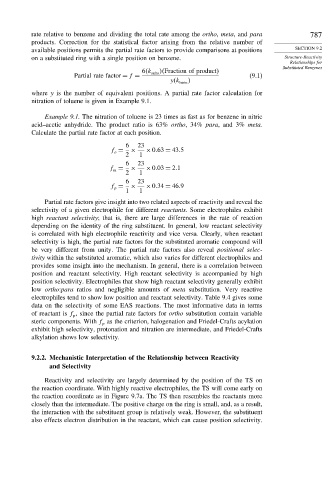Page 804 - Advanced Organic Chemistry Part A - Structure and Mechanisms, 5th ed (2007) - Carey _ Sundberg
P. 804
rate relative to benzene and dividing the total rate among the ortho, meta, and para 787
products. Correction for the statistical factor arising from the relative number of
available positions permits the partial rate factors to provide comparisons at positions SECTION 9.2
on a substituted ring with a single position on benzene. Structure-Reactivity
Relationships for
Substituted Benzenes
6 k subs Fraction of product)
Partial rate factor = f = (9.1)
y k
benz
where y is the number of equivalent positions. A partial rate factor calculation for
nitration of toluene is given in Example 9.1.
Example 9.1. The nitration of toluene is 23 times as fast as for benzene in nitric
acid–acetic anhydride. The product ratio is 63% ortho, 34% para, and 3% meta.
Calculate the partial rate factor at each position.
6 23
f = × ×0 63 = 43 5
o
2 1
6 23
f = × ×0 03 = 2 1
m
2 1
6 23
f = × ×0 34 = 46 9
p
1 1
Partial rate factors give insight into two related aspects of reactivity and reveal the
selectivity of a given electrophile for different reactants. Some electrophiles exhibit
high reactant selectivity; that is, there are large differences in the rate of reaction
depending on the identity of the ring substituent. In general, low reactant selectivity
is correlated with high electrophile reactivity and vice versa. Clearly, when reactant
selectivity is high, the partial rate factors for the substituted aromatic compound will
be very different from unity. The partial rate factors also reveal positional selec-
tivity within the substituted aromatic, which also varies for different electrophiles and
provides some insight into the mechanism. In general, there is a correlation between
position and reactant selectivity. High reactant selectivity is accompanied by high
position selectivity. Electrophiles that show high reactant selectivity generally exhibit
low ortho:para ratios and negligible amounts of meta substitution. Very reactive
electrophiles tend to show low position and reactant selectivity. Table 9.4 gives some
data on the selectivity of some EAS reactions. The most informative data in terms
of reactant is f , since the partial rate factors for ortho substitution contain variable
p
steric components. With f as the criterion, halogenation and Friedel-Crafts acylation
p
exhibit high selectivity, protonation and nitration are intermediate, and Friedel-Crafts
alkylation shows low selectivity.
9.2.2. Mechanistic Interpretation of the Relationship between Reactivity
and Selectivity
Reactivity and selectivity are largely determined by the position of the TS on
the reaction coordinate. With highly reactive electrophiles, the TS will come early on
the reaction coordinate as in Figure 9.7a. The TS then resembles the reactants more
closely than the intermediate. The positive charge on the ring is small, and, as a result,
the interaction with the substituent group is relatively weak. However, the substituent
also effects electron distribution in the reactant, which can cause position selectivity.

